This series explores my week distilling at Strathearn distillery in Perthshire. It gets pretty detailed so malt maniacs should love it. If you haven’t read my prologue post or my review of Strathearn distillery, now’s a good time to do that.
Ah, the first day of school. The excitement, the anxiety, the hangover?
Surprisingly, both Jeff and I were fairly chipper as we shuffled out of the apartment on that partly sunny Monday morning and drove toward Strathearn distillery. The Murray was a good friend, though he was half the man he used to be.
The gents at Strathearn were kind to us by providing a late 9:30am start time, and after passing through the town of Crieff and the farms of Perthshire’s bread basket we arrived right on time. The distillery’s HQ is a small, glass-fronted office in a farm’s renovated outbuilding. A trio of workstations and a tiny kitchen anchor the room’s corners, and a communal lunch table that serves whatever purpose they need (as you’ll soon learn) stands in the center. Strathearn is a small operation, and most of the team had been working for hours by the time we arrived.
We met Stuart McMillan, an amiable guy that has since left Strathearn, who gave us a brief tour of the distillery and made us feel at home. He laid out at a high level what to expect for the week, which included making gin and whisky and rolling up our sleeves to do the grunt work required on a small farm distillery without automation. Essentially, over the course of our week at the distillery we’d get to do a little bit of everything. Strathearn wasn’t distilling today, but we would be hand-filling bottles of their second-ever release of single malt. Trust me when I say that’s an honor and a huge responsibility to give to a couple of random guys on their first day of whisky school. Keep reading, you’ll see.
After setting expectations, Stuart handed us off to David Hogg, one of Strathearn’s two distillers and the so-called Master of Wood because he’s in charge of the distillery’s barrels. David worked closely with us the entire week and proved to be an amazing teacher with the patience of a saint and the quintessential dry humor of the Scots. He was busy in the middle of a wash run, the first distillation of fermented “wash” or what is basically an unhopped, malty beer, when we arrived.
The stillhouse was chilly that February morning and filled with the glorious aromas of yeast, malted barley, and fresh uisge beatha (or moonshine, clearac, newmake, whichever you prefer). The front of Strathearn’s stillhouse is dominated by their two primary stills: Wee Erin, a 500-liter spirit still, and Bella the Stripper, a 1000-liter wash still. David had filled Bella with 800L of wash earlier, and when we arrived she was close to producing the first drops of low wines, the weak spirit (~20-30% ABV) produced by the first distillation. Using steam-heated coils inside the still, Bella takes around 90 minutes to bring the 800L “charge” or volume of wash to 80°C when spirit begins to flow from the parrot, another piece of equipment used to float a hydrometer that measures the alcohol strength. Strathearn’s stills weren’t designed for steam coils — Tony, Strathearn’s owner and founder, wanted open flame beneath them but health and safety nixed the plan — and they retain a cool spot in the bottom of the still. To remedy this issue, the guys recirculate the wash through the still, thereby constantly mixing it, until the internal temperature reaches 60°C.
In some ways the wash distillation requires a little more attention than the subsequent spirit run. As the wash heats up inside Bella, a layer of frothing foam builds that can bubble up through the head of the still, down the lyne arm, the narrow copper tube running to the condenser, and into the condenser, which turns the low wines cloudy and full of undesirable proteins and compounds. We watched the foam level through Bella’s sight glass, turning the knob for the gas line up or down as needed. An old glove lay draped over this knob to protect your bare skin from its scorching heat. David grabbed a block of wood and knocked it against Bella’s flanks. Where the sound grew hollow you knew you were above the foam level, a little trick also used at Benromach.
At 80°C we cut the steam entirely and watched the foam inside Bella, then carefully turned it back on ensuring the foam was rolling and not working itself into waves. The vaporized alcohol drifts up through Bella’s head, down the lyne arm, and into the condenser, a tall copper cylinder filled with vapor-collecting tubes surrounded by cold water in the 10-15°C range. This temperature, and the temperature of the low wines, matters. If it’s too cold then the vapor has had less copper contact in the condenser, and the more copper contact the better since this is the crucible of single malt distillation’s alchemy. David didn’t turn on the water to the condenser until Bella was around ~90°C, which increases copper contact by making the condenser warmer, thereby delaying condensation.
We measured the flow rate from the parrot every 100ml. We’re aiming for 6-8s/100ml. This is an indication that Bella is operating with the correct amount of heat — Strathearn likes to run their stills low and slow. David conducted three tests five minutes apart, and we found the flow satisfactorily consistent. The correct flow is also apparent in the way the low wines spiral off the parrot, which was a bit of rule-of-thumb wisdom. We looked for four twists, and there they were.
At this point we relaxed a bit, let the spirit flow, and peered into one of the fermenters, which was toward the end of fermentation.
I shivered through most of the morning (Jeff was unaffected due to his outstanding constitution) and relished lunch in the office. Stuart had brought in one of Bennett’s of Dunblane’s famous steak pies and fitted it out with mashed potatoes and steamed vegetables. The team perked up at the sight of the pie — apparently it’s among the best in the area. My tastebuds concurred, and the filling repast kept me going the rest of the day.
With Bella happily chugging along we returned to the bonded warehouse and began emptying cask 50-03, a single malt that was three years and two months old. Using a good old-fashioned hand siphon I drained the cask into a food-grade pail. Earlier in the day, Stuart impressed upon us that spilling any whisky was seriously frowned upon. It’s worth more than gold.
Well, I spilled some.
Just a splash, I swear! I could hear the tendon’s in David’s neck stretching at the sight, but he helped cover up the crime and so on day one I already had a dark pact with one of the Mad Men of Methven. Draining the cask didn’t take very long so we might’ve had a few tastes from various other casks, like a 4th-fill 21yo cask from Tobermory, a Port cask filled with newmake, and Strathearn’s only cask of low wines-only single malt, which David turned up his nose at (the feints add a lot of character to whisky — don’t worry, this will make more sense in subsequent posts). We might’ve had those tastes, but…yeah, I can’t say for sure.
With the beautiful bucket in hand we headed into the office, filtered the whisky through what was effectively cheese cloth, and sat down to a table full of 70cl and 50cl bottles. Tony and the guys briefed us on our mission. Fill up a pitcher with single malt, carefully — carefully — fill each bottle to a specific point on the neck, cork it, and put on the neck wrapper.
This task doesn’t seem all that difficult on paper, but the reality is that it takes a lot of concentration and a steady hand to achieve the right flow from the pitcher into the narrow-necked bottles. We collected 34 liters of single malt whisky from cask 50-03, and it came out at 58.9% ABV, which was curious considering the spirit had entered the cask at 58% ABV. The secret is that water had evaporated during those three years, thereby raising the strength of the spirit.
As we filled bottles, I thought about a bit of wisdom Stuart bestowed upon us. A 50L cask like 50-03 is very small for the industry. A typical ex-Bourbon cask, the kind used by most Scottish distilleries, is 200L. When you vary the size of the cask you also vary the amount of time it takes to “age” the whisky. The spirit has more contact with wood in smaller casks, and this decreases the time the whisky will spend in the barrel since “wood contact,” much like copper contact, is the better part of aging. Wood imparts 70% of the flavor in single malt whisky, but it is also a purifier, ridding the spirit of undesirable compounds and allowing them to fill the glasses of disgruntled angels heavenward.
This cleansing process takes time. You might have all the flavor in the world after three years, but the wood might not have had the time to pull out those nasty compounds. This is where the spirit strength as it enters the barrel matters. Alcohol is an incredible solvent. It breaks down sugars and tannins in the wood that become part of the whisky’s flavor profile. But if it’s too strong for the size of the barrel, it does this work too quickly and must be emptied before the whisky becomes too woody. For this reason, Strathearn varies the strength of the newmake depending on the barrel size, using lower strengths for smaller casks. This calculation gives the spirit the right amount of time to gather the flavor from the wood while the wood removes the unwanted elements. Brilliance.
Bottling cask 50-03 took most of the day. We hand filled 38 70cl bottles and 13 50cl bottles, corked them, and applied the neck wrapping with a purpose-built machine Kenny, Strathearn’s post-production wizard, brought into the office. Tony told us this whisky would be used for tasting at events, and gifted us a quartet of 50ml bottles that were leftovers from the bottling.
Back in the stillhouse the wash distillation was coming to an end. The first drops of low wines come off the wash still anywhere in the 40-50% alcohol range, but by the time we ended the distillation at 1% the aggregate collection was firmly in the 20-30% range. David produced a case of fine, highly specialized hydrometers and a tome of reading tables to determine the spirit alcohol by volume that we used through the week. From the 800L charge we had collected around 250L of low wines.
As late afternoon waned into early evening it was time for cleaning. We turned off the steam to Bella, opened the vacuum release, and then hefted open her hatch. Steam billowed into the stillhouse, and while she was cooling we used hoses to pump the low wines out of the collection receiver into the huge primary low wines receiver nearby. A sludge called pot ale remained in Bella’s belly, and we pumped that out with another hose into a huge plastic tote outside the stillhouse. The pot ale can be recycled as feed or fertilizer on the farm. Following that we disconnected the lyne arm and hosed out both it and the condenser before finally hosing out Bella. Whew!
The day had come to an end, but before we left we picked out a Bossuet Armagnac cask to fill tomorrow. It’s hard to imagine how much we learned in one day, and though we were tired (and basically passed out in couches later) we were also energized and excited by what the rest of the week had in store.
As I drifted off to sleep, I remembered David saying something about gin…making gin on Samson and Delilah…Delilah…zzz
Disclosure: Strathearn provided me with a complimentary week of whisky school. All thoughts and opinions expressed here, as always, are my own.

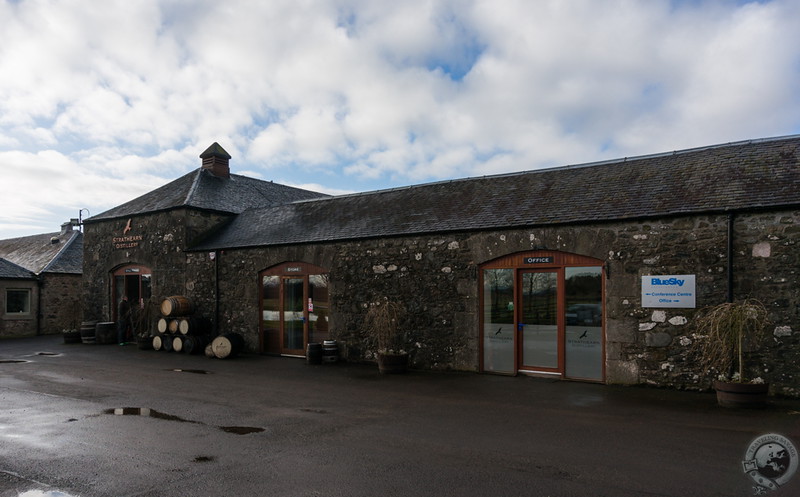
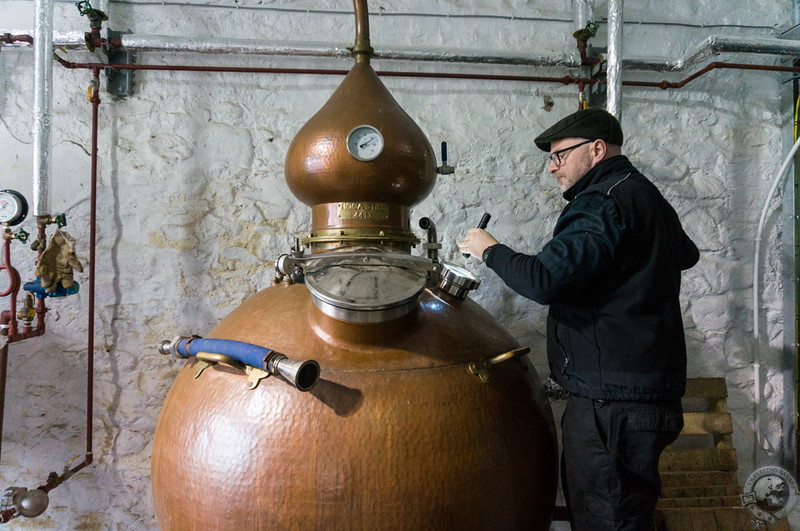
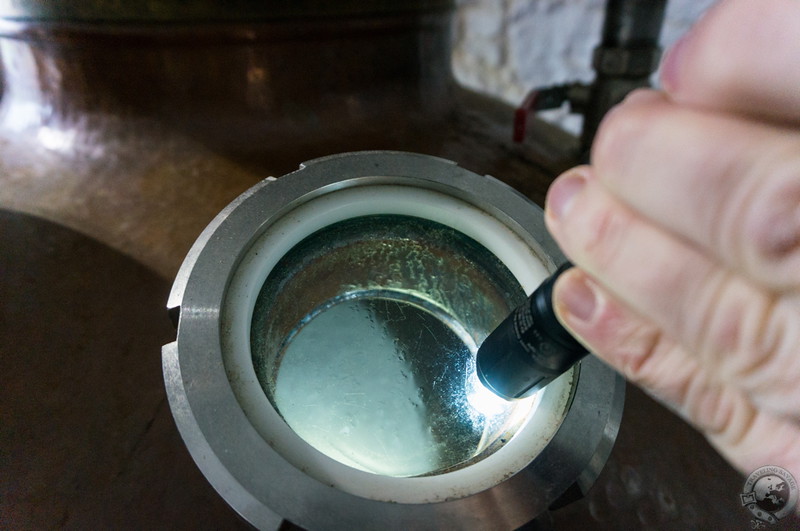
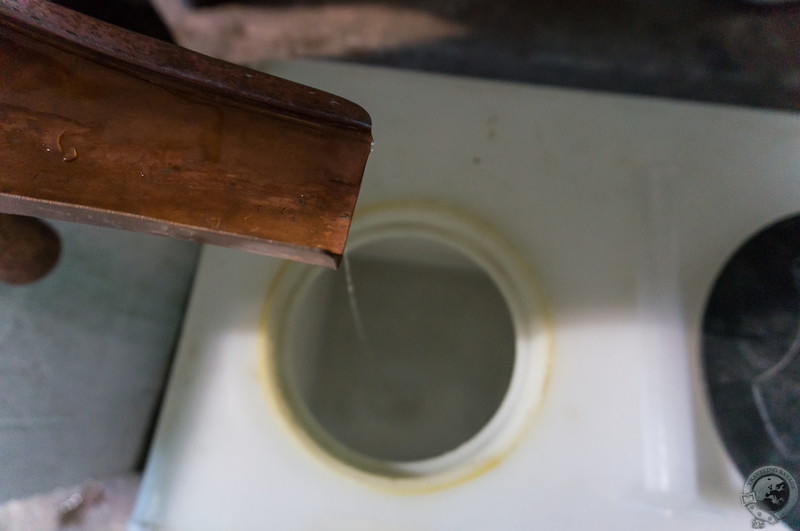
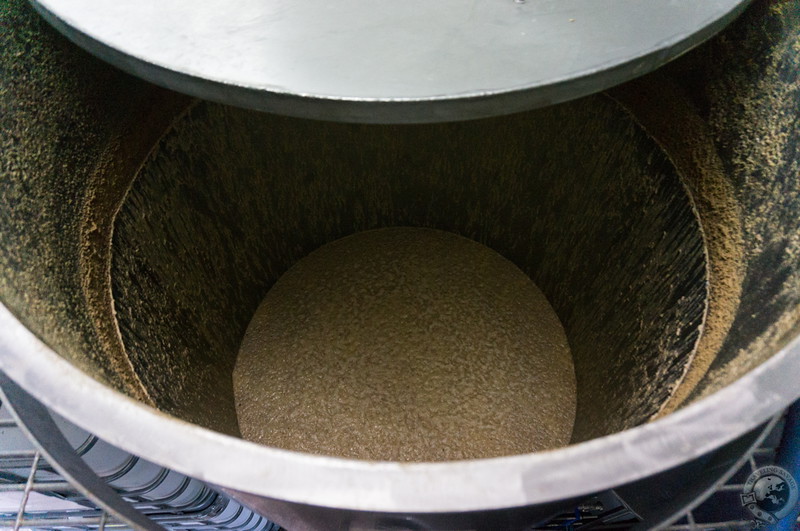
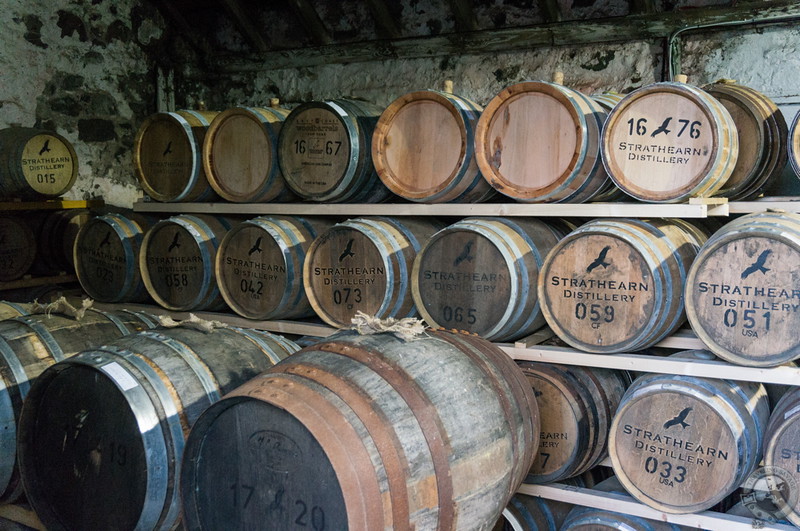
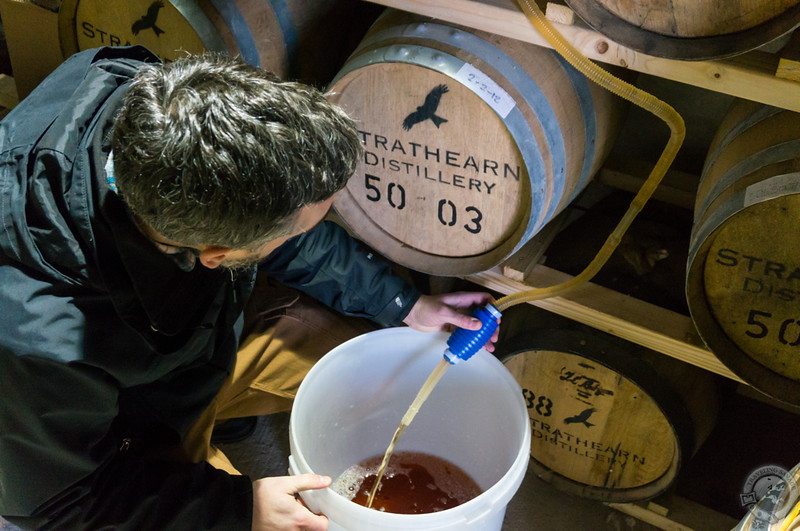
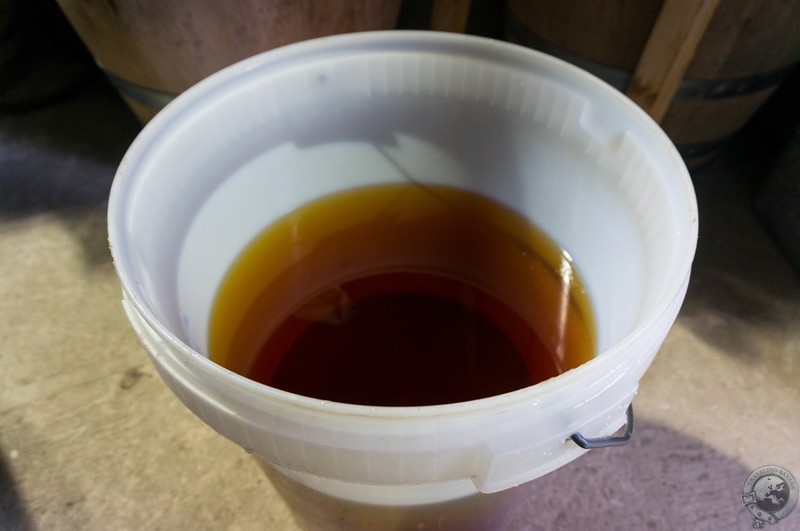
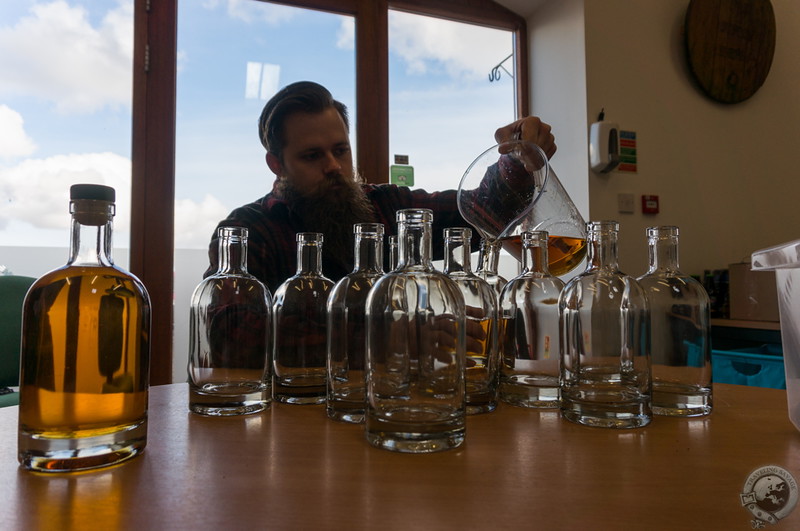
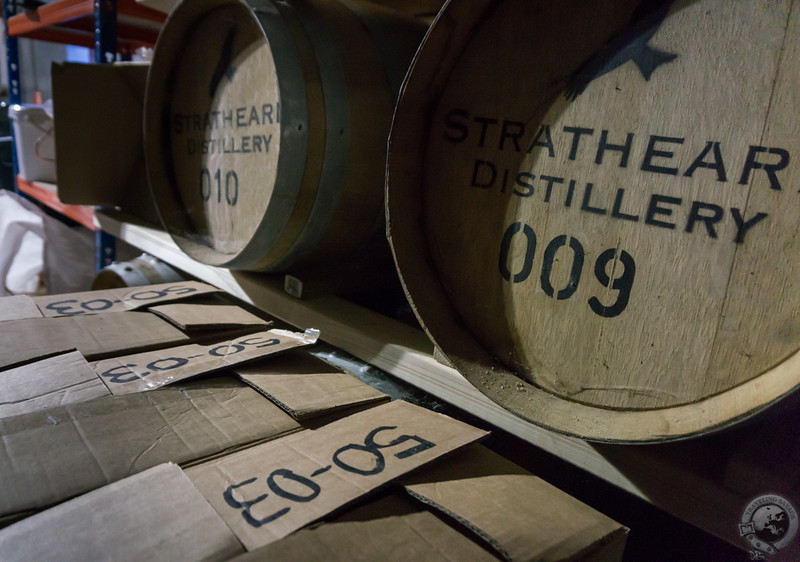
[…] my week distilling at Strathearn distillery in Perthshire. If you haven’t read the prologue, Day 1, Day 2, or my review of Strathearn, now’s a good time to do […]
[…] my week distilling at Strathearn distillery in Perthshire. If you haven’t read the prologue, Day 1, or my review of Strathearn, now’s a good time to do […]